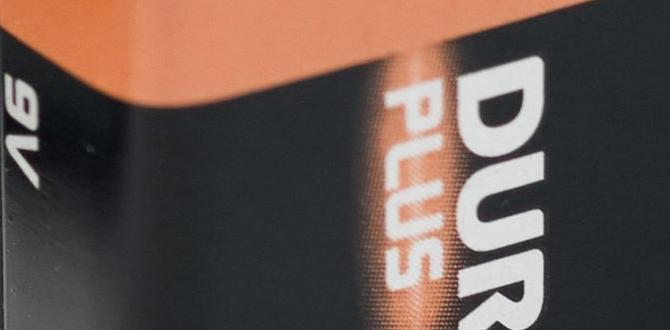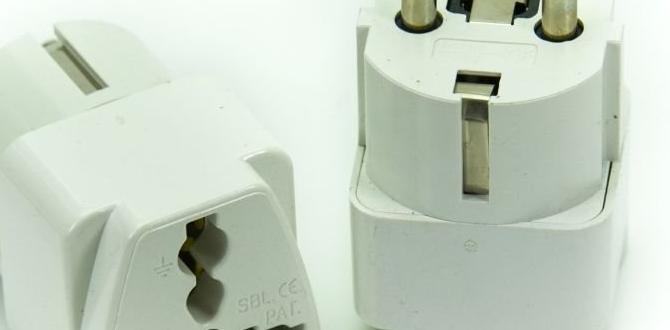Quick Summary: Need a budget-friendly stop-start battery for your Honda Civic? Choosing the right one ensures your car’s advanced start-stop system runs smoothly without breaking the bank. This guide helps you find a reliable, affordable option that fits your Civic perfectly, keeping you on the road longer.
Cheap Stop-Start Battery for Honda Civic: Essential Choice
Is your Honda Civic’s start-stop system acting up, or is it time for a new battery? The special batteries designed for these systems can sometimes feel like a pricey replacement. But don’t worry, there are perfectly good, affordable options out there that won’t cost a fortune. Finding the right “cheap stop-start battery for Honda Civic” is totally doable.
These systems save fuel by turning off the engine when you’re stopped, like at a traffic light, and then restarting it instantly when you lift your foot off the brake. This puts extra demands on the battery, so you need one built for the job. We’ll walk you through exactly how to find a dependable, wallet-friendly battery that keeps your Civic running efficiently.
This guide will break down everything you need to know, from understanding why these batteries are different to spotting the best deals. We’ll cover how to identify the right type, where to look for savings, and what to watch out for, making sure you get a great battery without overspending. Let’s get your Civic powered up affordably!
Why Your Honda Civic Needs a Specific Stop-Start Battery
Modern cars, like many Honda Civics, are increasingly equipped with intelligent features such as the start-stop system. This technology is designed to improve fuel efficiency and reduce emissions by automatically shutting off the engine when the car is stationary and restarting it instantly when you need to move again. This seemingly simple function places significantly higher demands on the car’s battery compared to older vehicles.
Traditional batteries are designed to provide a strong burst of power to start the engine once, and then they primarily maintain the car’s electrical systems while the engine is running. In contrast, a start-stop battery must endure frequent and deep discharge cycles. Every time the engine stops and starts, the battery is drained a little more and then recharged. This repeated cycling requires a battery that is built for resilience and longevity under these specific conditions.
These specialized batteries are often either Enhanced Flooded Batteries (EFB) or Absorbent Glass Mat (AGM) batteries. EFB batteries are a step up from standard flooded lead-acid batteries and can handle more frequent starts and deeper discharges. AGM batteries are even more robust, offering superior performance, longer lifespan, and better resistance to vibration, making them ideal for the rigorous demands of start-stop technology and vehicles with high electrical loads.
Using a standard, non-specialized battery in a car with a start-stop system can lead to premature battery failure. The battery simply won’t be able to cope with the frequent demands, resulting in reduced performance, unreliable engine starts, and ultimately, the need for an earlier replacement. Therefore, when looking for a replacement, it’s crucial to select a battery designed for start-stop applications to maintain the vehicle’s intended functionality and efficiency.
Understanding Battery Types: EFB vs. AGM
When hunting for a “cheap stop-start battery for Honda Civic,” you’ll encounter two main types designed for these systems: EFB and AGM. Knowing the difference helps you choose the right one for your specific Civic model and budget.
Enhanced Flooded Battery (EFB)
EFB batteries are the most common and often the most affordable option for vehicles with basic start-stop functionality. They are essentially an improved version of the standard flooded battery. EFB batteries have a thicker plate design and a more robust internal construction that allows them to handle more frequent cycling and deeper discharges than conventional batteries.
- How they work: EFB batteries use a unique material on the positive plates called carbon additives. This helps improve their ability to accept a charge and withstand the stress of frequent start-stop cycles.
- Best for: Vehicles with simpler start-stop systems that don’t have extensive electrical accessories or regenerative braking. They are a good upgrade from a standard battery for start-stop use.
- Pros:
- More affordable than AGM batteries.
- Better performance than standard flooded batteries for start-stop systems.
- Good lifespan for moderate use cases.
- Cons:
- Not as durable or long-lasting as AGM batteries under very demanding conditions.
- Less resistant to deep cycling than AGM.
Absorbent Glass Mat (AGM) Battery
AGM batteries are the premium choice for start-stop systems, especially in vehicles with higher electrical demands, including those with advanced features like regenerative braking or a larger number of electronic accessories. They offer superior performance and a longer lifespan.
- How they work: In an AGM battery, the electrolyte is suspended in fiberglass mats that are compressed between the battery plates. This design makes them spill-proof, highly vibration-resistant, and capable of handling very frequent and deep discharge cycles with high efficiency.
- Best for: Cars with advanced start-stop, regenerative braking, and high electrical loads (e.g., lots of electronic gadgets, heated seats, premium audio systems).
- Pros:
- Exceptional lifespan and durability.
- Can handle frequent and deep discharges very well.
- More efficient charging and discharging.
- Excellent vibration resistance.
- Spill-proof and maintenance-free.
- Cons:
- More expensive than EFB and standard batteries.
- Requires specific charging systems (some older alternators might not be compatible without modifications), though most modern cars handle this well.
Which One for Your Honda Civic?
The first step is to check your Honda Civic’s owner’s manual or look at the existing battery. It will specify whether your car came with an EFB or an AGM battery. If you have a basic start-stop system without many extra electronics, an EFB might be sufficient and more budget-friendly. If your Civic has advanced features or a more complex electrical system, replacing it with an AGM battery will provide the best performance and longevity, even if it’s a bit more upfront cost.
Choosing the “cheap stop-start battery for Honda Civic” often means finding the best value EFB battery if your car is compatible. If your Civic requires an AGM, then a good-value AGM will be your best “cheap” option, focusing on long-term reliability.
Identifying the Right Battery for Your Honda Civic
Finding the correct battery for your Honda Civic is crucial. Not just any battery will do, especially for a car equipped with a start-stop system. Here’s how to make sure you get the perfect fit.
1. Consult Your Owner’s Manual
This is the most reliable source of information. Your Honda Civic’s owner’s manual will clearly state the recommended battery type (EFB or AGM), the required group size, and the Cold Cranking Amps (CCA) and Reserve Capacity (RC) specifications. Adhering to these recommendations ensures optimal performance and avoids compatibility issues.
2. Check the Existing Battery
If you have access to your car and the current battery is the correct one, you can find the manufacturer’s label on it. This label typically displays the battery group size, terminal configuration, CCA rating, and sometimes the type (AGM or EFB). Note down all this information.
3. Use Online Battery Finders
Most reputable battery manufacturers and auto parts retailers have online tools or “battery finders” on their websites. You simply input your car’s make, model, year, and sometimes engine size, and the tool will show you compatible batteries. Double-check the specifications against your owner’s manual or existing battery for assurance.
4. Understand Battery Specifications
Here are the key specs to look for:
- Group Size: This refers to the physical dimensions and terminal placement of the battery. Common sizes for Civics include group 51R (common for import cars with positive terminal on the right), but always verify.
- Cold Cranking Amps (CCA): This measures the battery’s ability to start the engine in cold temperatures. While your Civic may have a specific requirement, often opting for a battery with a CCA rating equal to or slightly higher than the original is good. For start-stop systems, the responsiveness of the battery is also key.
- Reserve Capacity (RC): This indicates how long the battery can supply power if the alternator fails. A higher RC is generally better.
- Voltage: For standard cars, this is almost always 12 volts.
- Terminal Type: Ensure the terminals (posts) are oriented correctly (positive on left or right) to match your car’s cables. The ‘R’ in 51R, for example, usually indicates the positive terminal is on the right.
5. Confirm Start-Stop Compatibility
Crucially, make sure the battery is explicitly marked as suitable for start-stop systems. It will often be labeled as “AGM” or “EFB” and may even state “for vehicles with start-stop technology.” A standard car battery will not suffice.
Where to Find a Cheap Stop-Start Battery for Your Honda Civic
Finding an affordable battery requires a bit of savvy shopping. Here’s where you can look for cost-effective options:
1. Online Retailers
Websites like Amazon, eBay, and specialized online auto parts stores can offer competitive pricing. You can often find discounted brands or access sales events. Be sure to factor in shipping costs and read customer reviews carefully.
2. Big Box Auto Parts Stores
Major chains like AutoZone, Advance Auto Parts, O’Reilly Auto Parts, and Pep Boys often have their own store brands or budget-friendly options. These stores frequently run sales and promotions, and you can often pick up the battery the same day.
Pros:
- Convenience of immediate pickup.
- Often have in-store sales and loyalty programs.
- Staff can assist with identifying the right battery.
- Many offer free battery testing and installation (though check for start-stop specific limitations).
Cons:
- Prices can sometimes be higher than online alternatives unless a sale is active.
3. Warehouse Clubs
Stores like Costco and Sam’s Club are known for offering good value on batteries, often carrying reliable brands at lower prices. Availability for specific EFB or AGM start-stop batteries might vary, so check their inventory online or by visiting.
4. Dealerships (Use with Caution for “Cheap”)
While dealerships may have the exact OEM (Original Equipment Manufacturer) battery, these are rarely the cheapest option. If budget is a primary concern, a dealership is usually not the place to find a “cheap” battery. However, they are guaranteed to have the correct specification.
5. Independent Repair Shops
Your local mechanic might offer good pricing on batteries, especially if you have a relationship with them. They often have suppliers that provide them with batteries at wholesale prices they can pass on to you. It’s worth asking for a quote.
Tips for Saving Money on a Stop-Start Battery
Beyond just finding a lower-priced item, here are some tips to make your purchase even more economical:
- Look for Sales and Promotions: Battery prices fluctuate. Keep an eye out for holiday sales, seasonal discounts, and manufacturer rebates.
- Consider Store Brands: As mentioned, store brands from major auto parts retailers or warehouse clubs often provide a good balance of quality and price.
- Trade-in Your Old Battery: Most retailers will give you a credit or discount for returning your old battery. This is a universal practice due to the valuable lead content.
- Compare Prices: Don’t buy the first battery you see. Spend a few minutes comparing prices online and at different local stores.
- DIY Installation: If you’re comfortable with it, installing the battery yourself can save you the installation fee, which some retailers might charge. (See section on DIY installation below).
- Focus on Value, Not Just Price: A “cheap” battery that fails prematurely will cost you more in the long run. Prioritize a good warranty and reliability for the price.
DIY Battery Installation: A Cost-Saving Measure
Changing your own car battery can save you money on labor costs and is a relatively straightforward DIY project for most car owners. If you’re looking for a “cheap stop-start battery for Honda Civic” and want to minimize overall cost, doing it yourself is a great option.
Tools You’ll Need:
- Socket Wrench Set: You’ll need sockets that fit the battery terminal clamps (usually 10mm or 8mm) and the battery hold-down bracket (sizes vary by car).
- Wrench: Sometimes a specific wrench is needed for the hold-down.
- Wire Brush or Battery Terminal Cleaner: For cleaning the terminals and cable clamps.
- Gloves and Safety Glasses: Always protect yourself from battery acid and sparks.
- Battery Terminal Protector Spray/Grease: Optional, but helps prevent corrosion.
- Memory Saver (Optional but Recommended): A device that plugs into your car’s OBD-II port or cigarette lighter to maintain power to the car’s computer and radio presets while the battery is disconnected. This prevents loss of settings. You can find these online or at auto parts stores for a relatively low cost.
Steps for Replacing Your Honda Civic Battery:
- Safety First: Ensure the car is turned off, the parking brake is engaged, and you’re wearing safety glasses and gloves.
- Locate the Battery: In most Honda Civics, the battery is under the hood, typically on one side.
- Disconnect the Negative Terminal (-): Using your socket wrench, loosen the nut on the black cable clamp connected to the negative terminal. Carefully twist and pull the clamp off the post. Tuck it away so it can’t accidentally touch the terminal. Always disconnect the negative first.
- Disconnect the Positive Terminal (+): Now, loosen the nut on the red cable clamp connected to the positive terminal. Remove this clamp and tuck it away.
- Remove the Hold-Down Bracket: Locate the bracket that secures the battery in place. It might be at the base or on top of the battery. Use your socket wrench to remove the bolts holding it. Keep these parts safe.
- Remove the Old Battery: Carefully lift the old battery out of its tray. Batteries are heavy, so lift with your legs.
- Clean the Battery Tray and Cable Clamps: Use your wire brush or cleaner to remove any corrosion or debris from the battery tray and the inside of the cable clamps.
- Install the New Battery: Place the new battery into the tray, ensuring it’s oriented correctly (positive and negative terminals in the right positions).
- Secure the Hold-Down Bracket: Reinstall and tighten the hold-down bracket to secure the new battery firmly.
- Connect the Positive Terminal (+): Place the red clamp onto the positive terminal post and tighten the nut securely.
- Connect the Negative Terminal (-): Place the black clamp onto the negative terminal post and tighten the nut securely.
- Apply Terminal Protector (Optional): Spray or apply grease to the terminals to help prevent corrosion.
- Start Your Car: Start the engine to test the new battery. You may need to reset your clock and radio presets if you didn’t use a memory saver.
Remember to dispose of your old battery properly. Most auto parts stores and recycling centers accept them as they contain hazardous materials and valuable lead.
When to Consider a Premium Battery Over “Cheap”
While the focus is on finding a “cheap stop-start battery for Honda Civic,” there are times when paying a bit more for a premium option is the smarter financial choice. A premium battery, often an AGM from a well-known brand, might cost more upfront but can:
- Last Significantly Longer: A premium battery might last 5-7 years or more, whereas a very cheap EFB might only last 2-3 years under heavy use. Over time, this can make the premium option more cost-effective.
- Offer Better Reliability: You’re less likely to experience unexpected failures or performance issues with a high-quality battery, which can save you from towing costs, missed work, and inconvenience.
- Perform Better in Harsh Conditions: If you live in an area with extreme hot or cold temperatures, a premium battery will generally perform more reliably.
- Support Advanced Vehicle Features: If your Civic has many electronic features, or if you’re considering adding more, a robust premium battery can better handle the electrical load.
- Have Better Warranties: Higher-end batteries often come with longer warranties, offering greater peace of mind and protection against defects.
Consider the total cost of ownership over the battery’s lifespan and the potential cost of failure when making your decision. If your budget is extremely tight, a good-quality EFB from a reputable brand is a solid middle





